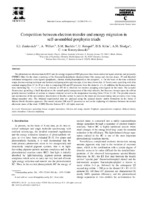Competition between electron transfer and energy migration in self-assembled porphyrin triads

Authors
Date
2001Bibliographic entry
Competition between electron transfer and energy migration in self-assembled porphyrin triads / E. I. Zenkevich [et al.] // Materials Science and Engineering C. – 2001. – Vol. 18, № 1-2. – P. 99-111.
Abstract
The photoinduced electron transfer (ET) and the energy migration (EM) processes have been studied in liquid solutions and polymeric (PMMA) films for the triads consisting of the Zn-octaethylporphyrin chemical dimer (the energy and electron donor, D) and dipyridyl substituted tetrapyrrole extra-ligands (porphyrins, chlorin, tetrahydroporphyrin) as the acceptors, A. On the basis of the time correlated single photon counting technique and femtosecond pump-probe spectroscopy, it has been shown that D fluorescence quenching with time constant ranging from 1.7 to 10 ps is due to competing EM and ET processes from the dimer to A's. In addition, the fluorescence decay time shortening (by ∼1.3–1.6 times in toluene at 293 K) is observed for electron accepting extra-ligands in the triads. The acceptor fluorescence quenching is hard dependent on the mutual spatial arrangement of the triad subunits, but becomes stronger upon the solvent polarity increase (addition of acetone to toluene solutions) as well as the temperature lowering (from 278 to 221 K). The possible reasons and mechanisms of the non-radiative deactivation of locally excited S₁-states in the triads are discussed taking into account a close lying charge-separated state. The obtained experimental data are analyzed using the reduced density matrix formalism in the frame of Haken–Strobl–Reineker approach. This model includes EM and ET processes as well as the dephasing of coherence between the excited electronic states of the triad. © 2001 Elsevier Science B.V. All rights reserved.
